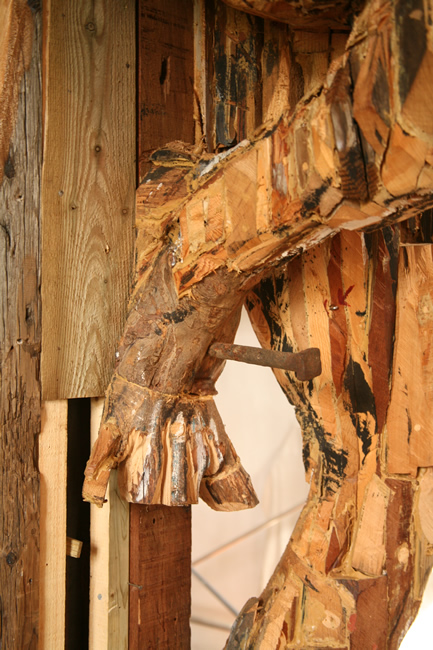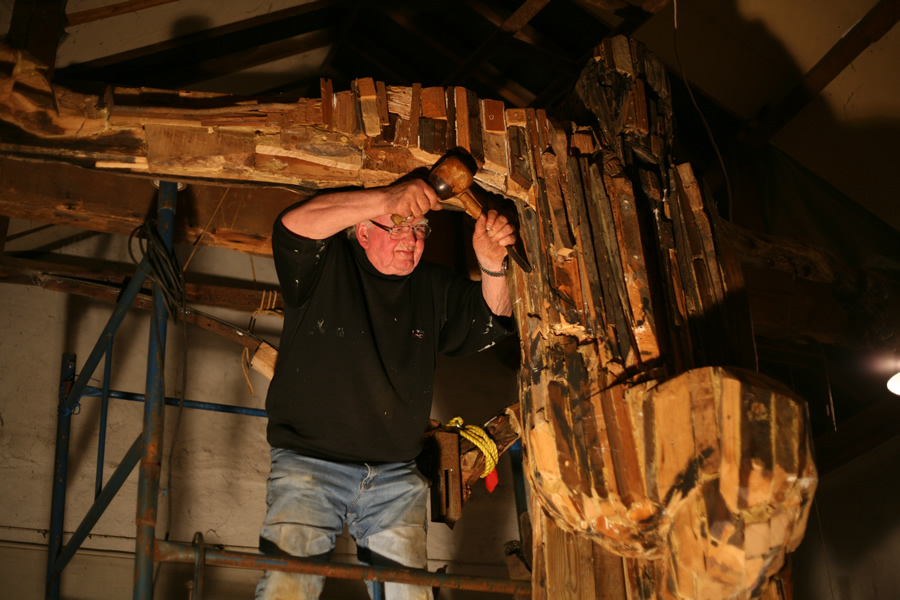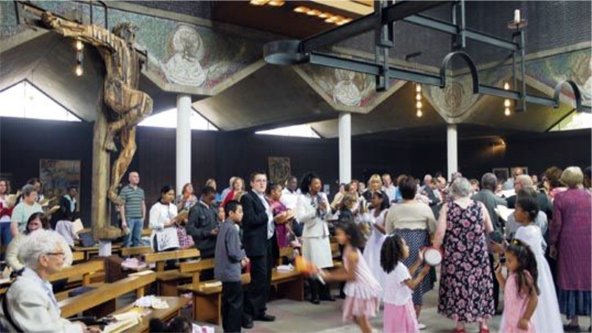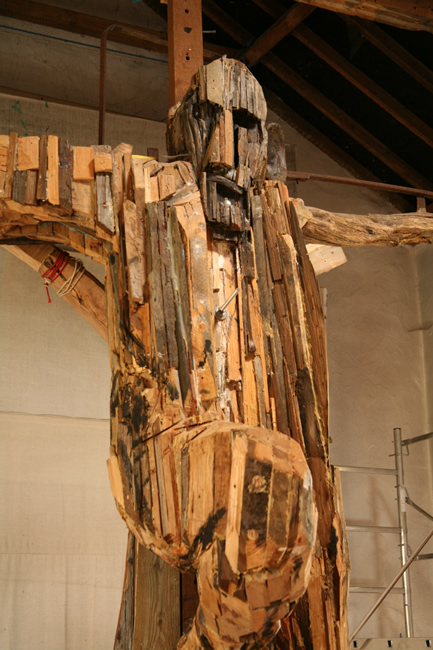Outraged Christ
/We but rarely deal directly with the domain of liturgical art, insomuch as it may be distinguished from liturgical furnishings and liturgical buildings. This is in part an intentional reaction against the treatment of architecture as art (as it is so narrowly defined in post-enlightenment modernity). For though this approach dominates popular architectural culture and criticism, it leads inevitably to the extravagant, to the pretentious, to the absurd. In order to focus on the church building as a lived reality rather than just an admired symbol, we must resist the urge to treat it solely in terms of representational meaning. The distinctions between artworks, buildings, and furnishings also arise from the very nature of these classes of artifacts and the human activities from which they result. For despite the close relationship between artworks, furnishings, and buildings (and the skills required in their making), each satisfies a distinct type of need, each derives its form from a different set of sources, and each has a unique mode of experience.
Briefly, the experience of furnishings (or utensils or tools or vessels) occurs subconsciously; their forms are recognizable from their utility without the need for analysis, unless they are so far embellished and developed that they become artworks. The experience of artworks occurs consciously, whether through direct analysis or simply through the distinct frame through which we approach and react to a work of art. Buildings could be considered a special case of either type, yet their experience is distinct enough to constitute a third type. If buildings were experienced only as furnishings, of what use and of what origin would be their infinity of forms. If they were experienced solely as artworks it would be impossible to accomplish much of anything else with their omnipresence demanding an emotional or intellectual reaction at every turn. Imagine exiting every building with that unique fatigue that comes after visiting a museum.
But the ultimate role of a building is to bind all three in concert. Of a church building this is particularly true as it must balance everything from the subconscious artifacts required for the liturgy with the more consciously emotional artifacts of devotional inspiration and tie them into a unified whole. In this role even the individual elements of the building itself (and not just the pieces it houses) may perform different of these functions. And in the very best churches, they may even switch functions depending on the situation, season, or inhabitant.
All of which is a longwinded and roundabout way to introduce to a post on a specific piece of liturgical art that is worthy of consideration both because of its merits as an artwork and the remarkable way in which it inhabits a particular church building capable of shifting its reading with a remarkable range of elements while still remaining fundamentally what it is.
The work is Outraged Christ by the English artist Charles Lutyens and the church is St Paul, Bow Common.
The imposing found-wood crucifix spent most of 2011 at St Paul, Bow Common as part of a retrospective of the work of Charles Lutyens entitled “Being in the World.” Lutyens created the large mosaics encircling the central atrium space of the church, so the location allows the retrospective to bring together the beginning and end of the artist’s career in a way that a gallery could not.
The retrospective and its centerpiece crucifix received a fair amount of attention, including this video feature from the BBC. At Easter 2012 it will also be featured in a Channel 4 (UK) documentary entitled “Icons of the Crucifixion.”
Richard Harries (The Rt Revd Lord Harries of Pentregarth, Gresham Professor of Divinity and Hon. Professor of Theology at King’s College, London) provided the following context for this “moving, impressive work”, originally published in the Church Times:
The first Christians liked to show Christ victorious on the cross. The medieval period focused on his suffering for the sins of the world. The 20th century, too, emphasised almost exclusively the suffering of Christ — but, more often than not, as a suffering of a terrible century. The depiction of an outraged Christ is, so far as I know, a fresh addition to Christian iconography.
Certainly it is therefore an image for the 21st century thus far, unless that is just my cynicism speaking. Harries later compares the work to an expression of Karl Barth’s assertion that “to clasp the hands in prayer is the beginning of an uprising against the disorder of the world,” and cynical or not, we need exactly that kind of prayer now.
Frequent readers will recognize the building, which was the subject of my graduate thesis. Completed in 1960 and designed by Robert Maguire & Keith Murray, St Paul, Bow Common is one of the exemplary post-war reconstruction churches in London. Its design was self-consciously modern and in many ways clearly the early work of two young headstrong designers (and an even head-strong-er old vicar); yet it also had an elemental simplicity rich enough and subtle enough to retain its powerful presence through a difficult half century.
When I visited in 2009, the current vicar Prebendary Duncan Ross described it to me by saying, “It breathes, this building,” and I’m not entirely confident he didn’t say “she.” It is not perfect, not a museum space in the way that a church such as Steven Holl’s St Ignatius Chapel remains pristine. But it better accommodates dwelling for more of the whole life of a community in the same way that you can’t quite imagine living in the houses featured in most architectural publications. At the same time–and this is truly the brilliance of the space–there is never a doubt of its central purpose.
The spatial complexity of the central atrium and surrounding peristyle cloister accomplishes this focus. The windowless outer walls of the building play host to a variety of rotating exhibits or displays, everything from the work of children to history displays to community information to art shows. The typical social functions of the narthex occurs in a space integral to the nave. Yet to enter the atrium volume with its massive glazed cupola is to leave behind whatever beauty or mundane clutter populates the outer wall without shutting it out completely. The focus on the altar created between the the spaces, furnishings, and artworks is so strong that the building achieves the feat of gathering in without shutting out.
Lutyen’s Outraged Christ arrives into this setting. The fact that it is of the same hand which made the mosaics certainly helps its integration. Both have a level of figural abstraction well suited to liturgical art. The head of Christ occupies the same height and visual plane as the heads of the angels. The scale of the crucifix perfectly suits the scale of the atrium, so much so that the work seems to fit as yet another element of the architecture itself.
But it also appears the building can integrate so significant a new focal point without leaving it as an individual, alien object. This is certainly not true of every church. Its rustic materiality more readily forgives so brash an object. Its collection of furnishings are themselves similarly objectified that they welcome another into their company. Above all, the crucifix joins in building the focus created by the concentric nested spaces and reinforced through the art program, materiality and lighting, and the furnishings. Which is why whatever merits or faults in the style or construction, this church represents an incredible achievement in realizing a church building’s role in unifying diverse artifacts into a worshipful whole, especially when those are not designed as a whole or even foreseen.
The future of the work is uncertain; it will remain at St Paul, Bow Common at least through 2012 as it seeks a permanent home. For my part, I hope that home is a fitting church where it can serve both as an astounding work of art and as integral element in the celebration of the sacred mysteries.
UPDATE: Further reflections and my own photos after visiting the work can be seen in this later post.




